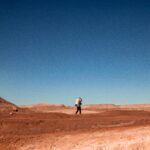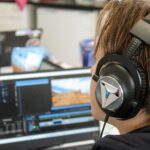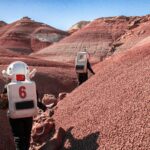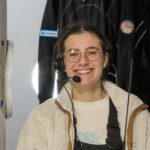[category science-report]
Crew 293 Mid Rotation Science Report 02Mar2024
Name of person filing report: Yves Bejach
Crew293 has been in the MDRS for two weeks now, conducting experiments while simulating life on Mars. We have done everything we could to make this simulation as accurate and relevant as possible. The current report aims to give the reader an understanding of what has been achieved and what is yet to come.
This report is organized as follows:
– Overview of all the experiments conducted during our mission, as found in the Mission Plan sent on Sol1, reminded here for clarity, and updated with the experiments’ current status.
Physics
Two experiments from the French National Center of Scientific Research (CNRS) have been performed at the MDRS for several years already. We are planning to gather additional data for this season as well. These activities will require EVAs.
· LOAC (Light Optical Aerosol Counter): LOAC is an optical aerosol counter, measuring the concentrations of different particles in the air and classifying them by size.
Related EVAs: Two EVAs planned for the first week to install the device. Every two days, the batteries will have to be changed and the data will have to be collected. The latter procedures can be part of other EVAs.
External points of contact: Jean-Pierre Lebreton and Jean-Baptiste Renard, CNRS.
Point of contact within the crew: Lea Bourgély.
· Mega-Ares: Mega-Ares is a sensor precisely measuring the electric field and the conductivity of the air. It is the little brother of Micro-Ares, the only payload of the Schiaparelli lander (ExoMars 2016). This year we also installed a wind-mill that will give us additional data.
Related EVAs: Performed simultaneously with the EVAs planned for LOAC. Two EVAs were planned for the first week to install the device. Every two days, the batteries will have to be changed and the data will have to be collected. The latter procedures can be part of other EVAs.
External points of contact: Jean-Pierre Lebreton and Jean-Baptiste Renard, CNRS.
Point of contact within the crew: Lea Bourgely.
Status: The instruments have been installed north of the Station, between the Hab and Marble Ritual. They have been collecting data since then. These data are retrieved every two days or so, when we change the batteries that power them. This will go on until Sol 26, when the instruments should be brought back to the station.
Technology
Technology demonstrations are planned, one of them being the continuation of the two last missions of ISAE-Supaero (Crew 263 and 275). They are based on technologies developed by the French Space Agency (CNES) and its health subsidiary (MEDES).
· AI4U: AI4U is an AI tool designed to help and assist astronauts in their daily tasks (environmental measurements, voice recognition). The aim is to test this AI assistant in real or close-to-real scenarios.
Related EVAs: None.
External points of contact: Gregory Navarro and Laure Boyer, CNES.
Point of contact within the crew: Mathurin Franck.
Status: The first week was dedicated to the setup and troubleshoot of the software. Crew293 has been able to test it daily since Sol8. We’ll continue running these daily tests next week, and the fourth week will be dedicated to data handling.
· Echofinder: Onboard the ISS, ultrasound scanners are teleoperated by trained specialists. As we travel further away from Earth, communication delays will increase and teleoperated devices will no longer be usable. The goal of Echofinder is to enable autonomous ultrasound acquisition sessions without any knowledge in medicine and any communication link with an experienced sonographer. The Echofinder tool uses augmented reality and an AI to help the operator capture usable imagery of the subject’s organs.
Related EVAs: None.
External point of contact: Aristée Thévenon, MEDES.
Point of contact within the crew: Yves Bejach.
Status: Acquisition sessions have started on Sol 2 and have been conducted approximately every two Sols. The crew member conducting the session is taking notes on everything that goes well or not with the software, and the setup and is taking ultrasound images that are to be analyzed to see if Echofinder is efficient.
· Photogrammetry: Re-conducting an experiment started by last year’s crew (Crew 275) which aims to determine how a 3D map created thanks to drone photogrammetry could improve an EVA crew’s performance during an outing.
Related EVAs: Three EVAs per week, starting the second week. The first one’s goal is to create the 3D map and decide where to position checkpoints on a designated area (one area per week). For the 2nd and 3rd ones, the EVA team will go to each checkpoint, having prepared the EVA using the standard 2D and 3D map respectively.
External point of contact: Alice Chapiron, ISAE Supaero student (Crew275)
Point of contact within the crew: Yves Bejach
Status: Started on Sol8 with an EVA aiming to create a 3D map of the East flank of North Ridge. Once the map was successfully created, two teams went out on different EVAs to go through designated checkpoints as efficiently as possible, having prepared with the 3D map and a classic 2D map respectively. Data collected has started to be processed. The same process will be iterated again on Week3 and Week4 of our mission.
Human factors
Human factors experiments are arguably the ones that benefit the most from taking place during an analog mission.
· Orbital Architecture: Measure of the stress of analog astronauts and of the influence of environmental parameters on the stress using Polar bands bracelets, sleep monitoring using Dreem headbands, questionnaires, evaluation of the position of the analog astronauts in the station, and environmental measurement (temperature, humidity, etc.).
Related EVAs: None.
External point of contact: Michail Magkos, KTH.
Point of contact within the crew: Lise Lefauconnier.
Status: The Crew has conducted cognitive assessments regularly since the beginning of the mission. In parallel, we are carrying Polar bands that monitor our heart rate, and location tracking chips that have been successfully installed early on during the first week. This will continue until the end of our rotation.
· MELiSSA: The MELiSSA project (Micro-Ecological Life Support System Alternative) is a European project led by the European Space Agency (ESA) aiming at developing a highly circular and regenerative life support system for space missions. The ALiSSE methodology (Advanced Life Support System Alternative) was developed as part of the project to provide an impartial evaluation tool of each technology system, including mass, energy and power, efficiency, crew time, crew risk, reliability, and durability. The proposed activity within the MELiSSA project focuses on the operational aspects of preparing recipes from higher plants and aims for a preliminary evaluation of the "crew time" criterion.
Related EVAs: None
External point of contact: Blandine Gorce, ESA
Point of contact within the crew: Mathurin Franck
Status: Every recipe that was planned for the first two weeks has been prepared. Resupply should allow us to continue as planned.
· Trace Lab: The purpose of this research is to better understand the role that emotion and coping strategies have on team dynamics within ICE (Isolated, Confined, Extreme) teams. The findings from this study will aid in the understanding of the role of affect within teams operating in ICE conditions – something that has been highlighted as being important by researchers, Antarctic expeditioners, and astronauts. Experiment conducted in collaboration with Trace Lab, University of Florida.
Related EVAs: None
External point of contact: Andres Kaosaar
Point of contact within the crew: Marie Delaroche
Status: The Crew has been filling out daily and weekly questionnaires since the beginning of the mission and will continue to do so until the end of the rotation.
· AMI – Anomalies Monitoring Interface: Software allowing random anomalies to occur within the station to simulate problems that could happen in a real environment and see how we could react. The main goal is to improve the simulation.
Related EVAs: Potentially emergency EVAs in case of depressurization of ammoniac leak. It is worth noting that such emergencies cannot be mistaken for real ones as it is not a problem that can occur within our earthly MDRS.
External point of contact: Quentin Royer, ISAE Supaero student (Crew275)
Point of contact within the crew: Marie Delaroche
Status: After some troubleshooting and last-minute adjustments during the first week, the beta version of AMI is now running. The Crew can now monitor the power distribution of the station and training anomalies have already occurred, enabling a deeper immersion. The interface is a work in progress; it will continue to run as we test new functions. We are expecting a new iteration of the software to be sent to the Crew as of tonight.
Outreach
· Media: Several articles and interviews in French newspaper and on radio
· Scientific mediation: We, like all Supaero Crews that came before us, try to share our passion for space and science in general by engaging in intervention in middle and high school. This year, we developed with high-schoolers a 3-step project around growing food on Mars.
Related EVAs: One as early as possible to retrieve some martian soil in which to plant radish seeds.
External point of contact: None
Point of contact within the crew: Mathurin Franck
Status: The plantation has been made early on; it is steadily growing under the advised care of our GreenHab Officer. Updates are regularly sent to the students that helped us create this experiment.
NB: In an effort to feel as immersed as possible, we asked Mission Support to play along with the simulation when communicating with us, which they did. For that Crew293 says thank you.









You must be logged in to post a comment.